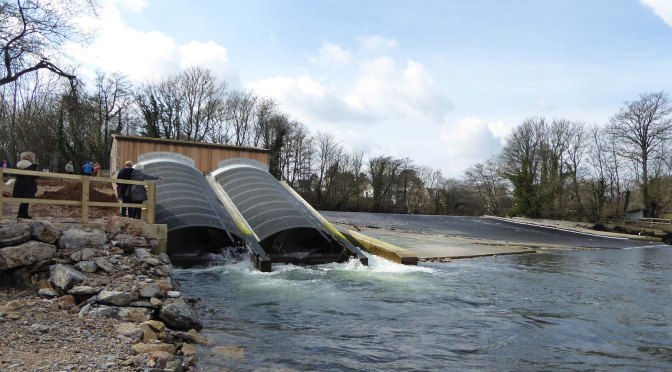A recent Sunday morning walk took us past the weir that crosses the river Dart about a mile upstream from Totnes. A weir was built here as early as the 16th century to divert water from the river along a leat so that its energy could power corn mills in the town The leat is still intact, but now meanders largely unnoticed through industrial estates and near supermarkets, though still attracting the occasional kingfisher. The Town Mill also still stands and has variously been the Tourist Information Centre, a Coffee Shop and home for the Local Image Bank. In the past decade, though, the weir has seen major change and rejuvenation with the construction of the Totnes Weir Hydro. Its twin Archimedes Screw-driven turbines once more harness the energy of the upper river, this time to generate electricity. [See picture of the weir and hydro at the head of this post]
Below the weir, the river is tidal and increasingly brackish with large sandbanks emerging at low tide. Today, these are gull territory where they squabble and shout at one another while fellow birds continually join and leave the party. Nearer the weir, small gangs of mallards, male and female, poke around in the water for food, taking little notice of children and their dogs playing nearby.
We pick our way downstream across the filigree of raised tree roots that covers the tidal area at the lower river’s edge. Across the water, a large, well-marked bird is swimming back and forth despite the brisk current. With its black head and long red beak above a largely white body this is a male goosander. The bird is paying attention to something floating in the water and, from this distance, this looks like a dead bird. I make out a chestnut head and grey body, possibly a female goosander, and my immediate reaction is that the male is mourning his dead mate. But no, I was wrong because, after a little more manoeuvring, the male hops briefly on to the female and when he is finished, she miraculously springs into life and swims about rapidly. My photos [see below] confirmed that she was far from dead but had adopted a submissive posture to encourage her chosen mate.





Really interesting to read about the goosander courtship. I wonder if they are a longterm pair and if goosanders mate for life – and whether this was their usual courtship routine. Also curious about where they will choose to nest – I think I’ve seen pairs further a little upriver. We saw some mandarins making a kerfuffle ‘nest choosing’ high up in close to river trees on the Dartington estate recently. The female appeared to be attracting the male to high up in the branches (or the other way around, it was a little confusing..)
LikeLike
Thanks Miriam, I have read that they form seasonal pairs and nest in holes in trees, sometimes high up, also in old logs on the ground. I think this is their normal courtship routine as, after the event, I found similar accounts elsewhere: https://earthstar.blog/2020/12/19/354-366-goosander-courtship/ and https://www.youtube.com/watch?v=soXDdBfSNOU
Interesting to hear about the mandarins. A couple of weeks ago we witnessed a kerfuffle on the river also on the Dartington estate. It was a dull day and without binoculars but it looked like little grebes on the far bank having some kind of altercation, competition for mates??.
LikeLiked by 2 people
How interesting! I know little about bird behaviour and I have never watched water birds very closely. Amelia
LikeLike
Glad you found it interesting!
LikeLiked by 1 person
Fascinating, Philip! I was really interested in the beautiful setting with some of the history of the town mill. But your visit had to be perfectly timed to be so close to the mating pair of water fowl. It must have been a very surprising “move” since you’d been anticipating the female as dead. You do have a keen eye and I admire your knowledge of the natural world, Philip. This was a delightful post.
LikeLike
Thanks Debra, pleased that you found this interesting. Totnes is a very old town with many features dating back hundreds of years, including the leat and mill.
LikeLike
A fascinating account. I was with you on that walk – so vividly described
LikeLike
Thanks Jenny, glad you liked it!
LikeLiked by 1 person
Goosanders bonds build up through the winter, often a number of females to a single male. The mating behaviour is something along the lines if the male points his head away from the female and stretches skyward. The female adopts a low stance. This goes on for a while before the female eventually takes up the submissive ‘dead bird’ pose, which signifies she’s ready, and she can stay like this for a while drifting on the water. Mating is quick afterwards the pair in effect reverse their role and often face away from each other skypointing to ‘cement’ their bonds, though the me doesn’t really get involved much after mating. Fascinating birds indeed.
LikeLike
Thanks Andrew, for reading and commenting, that’s fascinating information about Goosander bonding etc.and much appreciated.
LikeLike
Fascinating post Philip – nice to read about the rebirth of the weir as a modern energy source.
LikeLike
Thanks Martin, glad you liked it. The Totnes Hydro is a great success story!
LikeLike